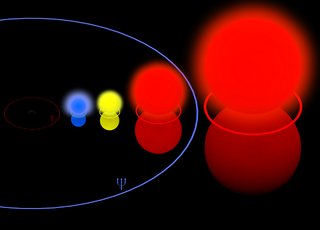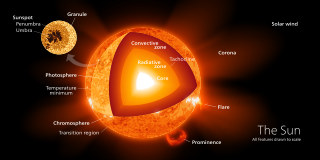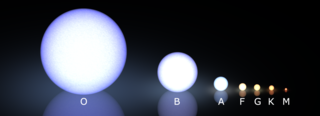In stellar astrophysics, the Schönberg–Chandrasekhar limit is the maximum mass of a non-fusing, isothermal core that can support an enclosing envelope. It is expressed as the ratio of the core mass to the total mass of the core and envelope. Estimates of the limit depend on the models used and the assumed chemical compositions of the core and envelope; typical values given are from 0.10 to 0.15 (10% to 15% of the total stellar mass). [1] [2] This is the maximum to which a helium-filled core can grow, and if this limit is exceeded, as can only happen in massive stars, the core collapses, releasing energy that causes the outer layers of the star to expand to become a red giant. It is named after the astrophysicists Subrahmanyan Chandrasekhar and Mario Schönberg, who estimated its value in a 1942 paper. [3] They estimated it to be

A star is type of astronomical object consisting of a luminous spheroid of plasma held together by its own gravity. The nearest star to Earth is the Sun. Many other stars are visible to the naked eye from Earth during the night, appearing as a multitude of fixed luminous points in the sky due to their immense distance from Earth. Historically, the most prominent stars were grouped into constellations and asterisms, the brightest of which gained proper names. Astronomers have assembled star catalogues that identify the known stars and provide standardized stellar designations. However, most of the estimated 300 sextillion (3×1023) stars in the Universe are invisible to the naked eye from Earth, including all stars outside our galaxy, the Milky Way.
Astrophysics is the branch of astronomy that employs the principles of physics and chemistry "to ascertain the nature of the astronomical objects, rather than their positions or motions in space". Among the objects studied are the Sun, other stars, galaxies, extrasolar planets, the interstellar medium and the cosmic microwave background. Emissions from these objects are examined across all parts of the electromagnetic spectrum, and the properties examined include luminosity, density, temperature, and chemical composition. Because astrophysics is a very broad subject, astrophysicists apply concepts and methods from many disciplines of physics, including mechanics, electromagnetism, statistical mechanics, thermodynamics, quantum mechanics, relativity, nuclear and particle physics, and atomic and molecular physics.

Subrahmanyan Chandrasekhar was an Indian American astrophysicist who spent his professional life in the United States. He was awarded the 1983 Nobel Prize for Physics with William A. Fowler for "...theoretical studies of the physical processes of importance to the structure and evolution of the stars". His mathematical treatment of stellar evolution yielded many of the best current theoretical models of the later evolutionary stages of massive stars and black holes. The Chandrasekhar limit is named after him.
The Schönberg–Chandrasekhar limit comes into play when fusion in a main-sequence star exhausts the hydrogen at the center of the star. The star then contracts until hydrogen fuses in a shell surrounding a helium-rich core, both of which are surrounded by an envelope consisting primarily of hydrogen. The core increases in mass as the shell burns its way outwards through the star. If the star's mass is less than approximately 1.5 solar masses, the core will become degenerate before the Schönberg–Chandrasekhar limit is reached, and, on the other hand, if the mass is greater than approximately 6 solar masses, the star leaves the main sequence with a core mass already greater than the Schönberg–Chandrasekhar limit so its core is never isothermal before helium fusion. In the remaining case, where the mass is between 1.5 and 6 solar masses, the core will grow until the limit is reached, at which point it will contract rapidly until helium starts to fuse in the core. [1] [4]

Hydrogen is a chemical element with symbol H and atomic number 1. With a standard atomic weight of 1.008, hydrogen is the lightest element in the periodic table. Its monatomic form (H) is the most abundant chemical substance in the Universe, constituting roughly 75% of all baryonic mass. Non-remnant stars are mainly composed of hydrogen in the plasma state. The most common isotope of hydrogen, termed protium, has one proton and no neutrons.

The solar mass (M☉) is a standard unit of mass in astronomy, equal to approximately 2×1030 kg. It is used to indicate the masses of other stars, as well as clusters, nebulae, and galaxies. It is equal to the mass of the Sun (denoted by the solar symbol ⊙︎). This equates to about two nonillion (two quintillion in the long scale) kilograms:











